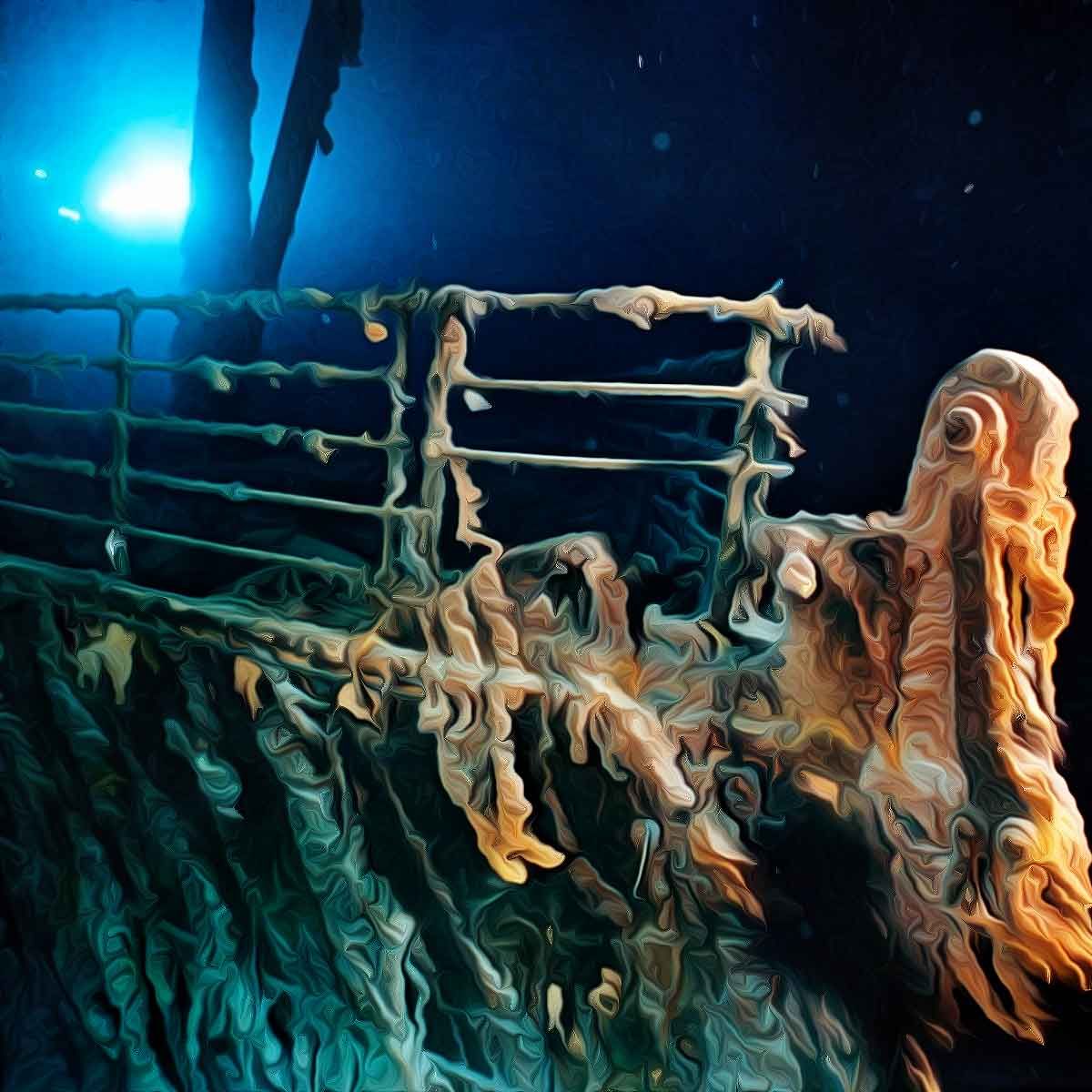MORE COVERAGE
Twitter Coverage
Satyaagrah
Written on
Satyaagrah
Written on
Satyaagrah
Written on
Satyaagrah
Written on
Satyaagrah
Written on
JOIN SATYAAGRAH SOCIAL MEDIA
"Research is formalized curiosity. It is poking and prying with a purpose": Full-sized digital scan of the Titanic, which lies 3,800 m (12,500 ft) down in the Atlantic, has been created using deep-sea mapping, providing a unique 3D view of the entire ship

The wreckage of the RMS Titanic, which sank in the North Atlantic Ocean on April 15, 1912, has been the subject of numerous expeditions, research efforts, and documentaries aimed at uncovering more information about the ship and its tragic fate.
|
The first people to dive down to the Titanic in nearly 15 years say some of the wrecks is deteriorating rapidly.
Over the course of five submersible dives, an international team of deep-sea explorers surveyed the sunken ship, which lies 3,800m down in the Atlantic.
While parts of the wreck were in surprisingly good condition, other features had been lost to the sea.
The worst decay was seen on the starboard side of the officers' quarters.
Titanic historian Parks Stephenson said some of what he saw during the dive was "shocking".
"The captain's bathtub is a favourite image among Titanic enthusiasts - and that's now gone," he said.
"That whole deck house on that side is collapsing, taking with it the state rooms. And that deterioration is going to continue advancing."
He said the sloping lounge roof of the bow section would probably be the next part to be lost, obscuring views of the ship's interior.
"Titanic is returning to nature," he added.
Strong ocean currents, salt corrosion, and metal-eating bacteria are attacking the ship.
The RMS Titanic has been underwater for more than 100 years, lying about 600km (370 miles) off the coast of Newfoundland, Canada.
The passenger liner, which was the largest ship of its time, hit an iceberg on its maiden voyage from Southampton to New York in 1912. Of the 2,200 passengers and crew onboard, more than 1,500 died.
The Titanic expedition was carried out by the same team that recently made the deepest-ever plunge to the bottom of the Mariana Trench, which lies nearly 12km down the Pacific Ocean.
The dives took place in a 4.6m-long, 3.7m-high submersible - called the DSV Limiting Factor - which was built by the US-based company Triton Submarines.
Navigating the sub around the wreck, which lies in two main pieces about 600m apart, was challenging.
Bad weather in the Atlantic and strong underwater currents made the dives difficult. Getting entangled with the wreck was also a significant risk for the team.
One of the most significant explorations of the Titanic wreckage occurred in 1985 when Dr. Robert Ballard, a renowned oceanographer and explorer, led an expedition to discover the ship's remains. Using advanced sonar technology and remotely operated vehicles (ROVs), Ballard and his team located the wreckage at a depth of approximately 12,500 feet (3,800 meters). The discovery took place nearly 73 years after the Titanic sank.
The expedition gave the world the first comprehensive view of the Titanic's final resting place. The ship's bow and stern sections were found lying about half a mile (0.8 kilometers) apart, scattered across the ocean floor. The wreckage revealed crucial details about the ship's condition and dispelled several misconceptions about its final moments.
Subsequent expeditions, including those led by James Cameron in 1995 and 2001, continued to document and explore the Titanic wreckage. Cameron's expeditions employed advanced ROVs equipped with high-definition cameras, enabling researchers to capture detailed imagery and video footage of the site.
These expeditions revealed important insights into the ship's deterioration over time, as well as the diverse marine life that has colonized the wreckage. They also helped preserve the historical record by creating detailed maps and 3D models of the site.
In recent years, technology has continued to play a significant role in documenting the Titanic wreckage. Autonomous underwater vehicles (AUVs) equipped with advanced imaging systems have been deployed to capture high-resolution imagery of the site. Additionally, unmanned ROVs have been used to explore areas that were previously inaccessible.
The ongoing research has focused on studying the corrosion and degradation of the ship's hull, understanding the impact of the ocean environment on the wreckage, and documenting the marine ecosystem that has developed around it. These efforts have provided valuable data to assess the long-term preservation of the site and its historical significance.
It's important to note that while these expeditions and research initiatives have contributed greatly to our understanding of the Titanic and its tragic sinking, there are ethical considerations surrounding the exploration and potential disturbance of the wreckage. Many view the site as a memorial and the final resting place of the victims, prompting discussions about how to balance scientific exploration with preservation and respect.
Overall, the exploration and research of the Titanic wreckage have allowed us to gain valuable insights into this historic event, providing a window into the past and honoring the lives that were lost. It remains an ongoing endeavor as technology advances and new discoveries are made.
|
A History of Titanic Exploration
1985 - Titanic site discovered by American-French team
1986 - Submersible Alvin explores the wreck
1987 - First salvage expedition collects 1,800 Titanic artifacts
1995 - James Cameron visits the wreck-footage is used in his film Titanic
1998 - First tourists dive there
1998 - Section of the Titanic hull is raised
2005 - Two crewed submersibles dive to the wreck
2010 - Autonomous robots map the site
2012 - Wreck now protected by Unesco
2019 - DSV Limiting Factor sub makes five dives
The dives have been filmed by Atlantic Productions for a forthcoming documentary.
As well as capturing footage, scientists on the expedition have also been studying the creatures living on the wreck.
Despite the near-freezing conditions, pitch-black waters, and immense pressure, life is thriving there.
This though, said expedition scientist Clare Fitzsimmons, from Newcastle University, was a factor in the Titanic's decay.
"There are microbes on the shipwreck that are eating away the iron of the wreck itself, creating 'rusticle' structures, which is a much weaker form of the metal," she said.
These rusticles - stalactites of rust hanging off the wreck - are so fragile that they can crumble into a cloud of dust if disturbed.
The scientists are studying how different types of metal erode in the deep Atlantic waters, to assess how much longer the Titanic has left.
Commenting on the expedition, Robert Blyth from the National Maritime Museum in Greenwich said it was important to go down and document the wreck in its current state.
"The wreck itself is the only witness we've now got of the Titanic disaster," he said.
"All of the survivors have now passed away, so I think it's important to use the wreck whilst the wreck still has something to say."
References:
 Support Us
Support Us
Satyagraha was born from the heart of our land, with an undying aim to unveil the true essence of Bharat. It seeks to illuminate the hidden tales of our valiant freedom fighters and the rich chronicles that haven't yet sung their complete melody in the mainstream.
While platforms like NDTV and 'The Wire' effortlessly garner funds under the banner of safeguarding democracy, we at Satyagraha walk a different path. Our strength and resonance come from you. In this journey to weave a stronger Bharat, every little contribution amplifies our voice. Let's come together, contribute as you can, and champion the true spirit of our nation.
 |  |  |
| ICICI Bank of Satyaagrah | Razorpay Bank of Satyaagrah | PayPal Bank of Satyaagrah - For International Payments |
If all above doesn't work, then try the LINK below:
Please share the article on other platforms
DISCLAIMER: The author is solely responsible for the views expressed in this article. The author carries the responsibility for citing and/or licensing of images utilized within the text. The website also frequently uses non-commercial images for representational purposes only in line with the article. We are not responsible for the authenticity of such images. If some images have a copyright issue, we request the person/entity to contact us at satyaagrahindia@gmail.com and we will take the necessary actions to resolve the issue.
Related Articles
- Ten most compelling evidence of Extraterrestrial existence from 2020
- "Entrepreneurship is the launching of surprises": Apple unveiled its long-awaited augmented reality (AR) headset, named the Vision Pro, as it sought to make its entry into a market currently dominated by Meta, the social media giant owned by Facebook
- "Titanic was called the Ship of Dreams, and it was. It really was": Deep-Sea Tragedy: The Catastrophic Implosion of Titan Submersible and the Lives Lost, it was on a mission to explore the Titanic, a ship that itself met a tragic end on its maiden voyage
- Are We Alone in the Universe? NASA hints at the possibility of extra-terrestrial life, wants to establish New framework
- "Tech Tycoon Tango": OpenAI, the brain behind ChatGPT, says 'game over' to CEO Sam Altman, Co-founder Greg Brockman follows suit, bidding adieu; board's 'confidence vote' seems more like a plot twist in a tech thriller. Who's scripting this, AI or humans?
- "We live in a world defined by the rapid pace of technological change": India is experiencing tremendous economic growth under PM Modi. Look forward to continuing our strong partnership and supporting India's G20 presidency - Google CEO Sundar Pichai
- India embarks on a transformative journey, aiming to launch its first semiconductor chip in Dec 2024 & to inaugurate a cutting-edge bullet train by 2026 under PM Modi's ambitious vision for technological self-reliance and the unification of economic zones
- "Research is creating new knowledge, without which there is no progress": National Research Foundation - a visionary initiative by the Indian govt aimed at centralizing funding for scientific & academic research with an ambitious target of ₹50,000 crore
- "And the winds and the waves are always on the side of the ablest navigators": ISRO successfully launched GSLV-F12/NVS-01 Mission from SDSC-SHAR, Sriharikota, NVS-01 first of the India's second-generation NavIC satellites that accompany enhanced features
- Chandra - NASA’s advanced X-Ray Observatory is named after a brilliant Indian scientist & Nobel Prize-winner Subrahmanyan Chandrasekhar, a Flagship-class space telescope is an Earth satellite in a 64-hour orbit, notably its mission is ongoing as of 2023
- "Cyberspace undeniably reflects some form of geography": Ashwini Vaishnaw launched "Bharat 6G Alliance" for better collaboration between Govt, industry and academia in developing indigenous 6G products, India already has 200+ patents for 6G
- "If art is to have a special train, the critic must keep some seats reserved on it": In a momentous event, PM Narendra Modi flagged off Puri-Howrah Vande Bharat Express in Odisha, marking a significant milestone in India's railway infrastructure evolution
- ISRO successfully tested the Gaganyaan Service Module Propulsion System (SMPS) on July 19, 2023 at ISRO Propulsion Complex (IPRC) , Mahendragiri
- "Driving the future, pod by pod": IIT Madras' Avishkar Hyperloop team is spearheading a transportation revolution, with global accolades, a prototype in place, & national backing, they're not just envisioning, but shaping future of rapid transit in India
- "Stars align when nations dream together": Beyond defense & trade, Armenia's ambition to explore space with India marks a profound alliance, transcending terrestrial boundaries, this partnership is a beacon of unity, collaboration and a harmonious future

























